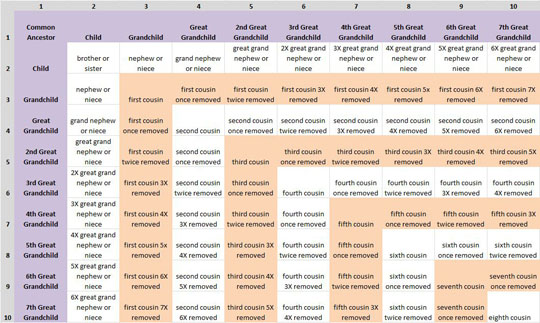This can be demonstrated with an example. Suppose Relative A was the great great great grandchild of the common ancestor. Go across the first row until you get to the “3rd Great Grandchild”. You can see that Relative A is the 6th generation of the common ancestor.

Now suppose Relative B was the great grandchild of the common ancestor. Going down the first column, this would make Relative B the 4th generation of the common ancestor.
The point where the row and column cross determines the relationship between Relative A and Relative B. In this case, the two relatives are second cousins twice removed (the point where the 6th column and the 4th row cross).
It can take a while to get use to this process. However, this methodology can be used to find the relationship between any two people in a family tree. To make the process easier, we have provided a convenient pdf version of the Family Tree Relationship Chart that you can print out and keep for your records. With a bit of practise, the process becomes fairly straightforward for even relatively convoluted cases.
Another Approach
There are alternate ways to understand family relationships. One method is to visualize a family tree.
It is possible to determine the relationship between any two people by moving up and down as well as across a family tree diagram. This method is described in the following fun video.
Some Additional Terms
To assist you further, here are some additional terms that you may come across in your family tree research. These terms do not appear on the Family Tree Relationship Chart:
Paternal Cousin: A cousin from the father’s side of the family.
Maternal Cousin: A cousin from the mother’s side of the family.
Double Cousin: Cousins that are related on both the paternal side and the maternal side of the family. This could occur, for example, if two sisters in one family married two brothers from another family. Their offspring would be double cousins.

